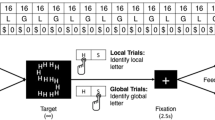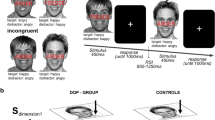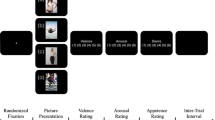Abstract
Previous studies have found that affective states with high motivational intensity narrow attentional scope, whereas affective states with low motivational intensity broaden attentional scope. This conclusion, however, is based on fragmented evidence based on several separate studies. The present study tests this conclusion within a single study using both behavioral (Experiment 1) and neurophysiological (Experiment 2) measures. Experiment 1 showed that individuals had the global precedence effect in the neutral affective state. However, the global precedence effect was reduced for affective states with high motivational intensity, whereas the global precedence effect was not significantly enhanced for those with low motivational intensity. Experiment 2 replicated these results with event-related potential (ERP) recording. ERP results showed that affective states with high motivational intensity induced smaller N2 and greater late positive potential (LPP) amplitudes than low motivational intensity and neutral affective states. However, no differences were found between the low motivational intensity and neutral affective states. Furthermore, smaller LPP predicted the tendency a global attentional focus in the frontal and central areas and larger LPP predicted a narrowed focus in the frontal area. The findings suggested that high motivational intensity of affective states can affect attentional scope.



Similar content being viewed by others
References
Beaucousin V, Simon G, Cassotti M, Pineau A, Houdé O, Poirel N (2013) Global interference during early visual processing: ERP evidence from a rapid global/local selective task. Front Psychol. doi:10.3389/fpsyg.2013.00539
Beck AT, Epstein N, Brown G, Steer RA (1988) An inventory for measuring clinical anxiety: psychometric properties. J Consult Clin Psychol 56:893–897
Briggs KE, Martin FH (2009) Affective picture processing and motivational relevance: arousal and valence effects on ERPs in an oddball task. Int J Psychophysiol 72:299–306
Britton JC, Phan KL, Taylor SF, Welsh RC, Berridge KC, Liberzon I (2006) Neural correlates of social and nonsocial emotions: an fMRI study. Neuroimage 31:397–409
Burke A, Heuer F, Reisberg D (1992) Remembering emotional events. Mem Cogn 20:277–290
Cacioppo JT, Berntson GG (1994) Relationships between attitudes and evaluative space: a critical review, with emphasis on the separability of positive and negative substrates. Psychol Bull 115:401–423
Chajut E, Algom D (2003) Selective attention improves under stress: implications for theories of social cognition. J Pers Soc Psychol 85:231–248
Easterbrook JA (1959) The effect of emotion on cue utilization and the organization of behavior. Psychol Rev 66:183–201
Elliot AJ, Maier MA, Moller AC, Friedman R, Meinhardt J (2007) Color and psychological functioning: the effect of red on performance attainment. J Exp Psychol Gen 136:154–168
Fazio RH (1990) A practical guide to the use of response latencies in social psychological research. In: Hendrick C, Clark MS (eds) Review of personality and social psychology, vol 11. Sage, Newbury Park, pp 74–97
Folstein JR, Van Petten C (2008) Influence of cognitive control and mismatch on the N2 component of the ERP: a review. Psychophysiology 45:152–170
Fox E (2008) Emotion science: cognitive and neuroscientific approaches to understanding human emotions. Palgrave Macmillan, New York
Fredrickson BL (2001) The role of positive emotions in positive psychology: the broaden and build theory of positive emotions. Am Psychol 56:218–226
Fredrickson BL, Branigan C (2005) Positive emotions broaden the scope of attention and thought-action repertoires. Cogn Emot 19:313–332
Friedman RS, Forster JF (2001) The effects of promotion and prevention cues on creativity. J Pers Soc Psychol 81:1001–1013
Gable PA, Harmon-Jones E (2008) Approach-motivated positive affect reduces breadth of attention. Psychol Sci 19:476–482
Gable PA, Harmon-Jones E (2010a) The blues broaden, but the nasty narrows: attentional consequences of negative affects low and high in motivational intensity. Psychol Sci 21:211–215
Gable PA, Harmon-Jones E (2010b) Late positive potential to appetitive stimuli and local attentional bias. Emotion 10:441–446
Gable PA, Harmon-Jones E (2013) Does arousal per se account for the influence of appetitive stimuli on attentional scope and the late positive potential? Psychophysiology 50:344–350
Gratton G, Coles MGH, Donchin E (1983) A new method for off-line removal of ocular artifact. Electroencephalogr Clin Neurophysiol 75:468–484
Hajcak G, Dennis TA (2009) Brain potentials during affective picture processing in children. Biol Psychol 80:333–338
Hajcak G, Weinberg A, MacNamara A, Foti D (2012) ERPs and the study of emotion. In: Luck SJ, Kappenman ES (eds) Oxford handbook of ERP components. Oxford University Press, NewYork
Han S, Chen L (1996) Processing of global and local properties: an analysis with event-related brain potentials. Sci China C Life Sci 39:179–188
Han S, Fan S, Chen L, Zhuo Y (1997) On the different processing of wholes and parts: a psychophysiological study. J Cogn Neurosci 9:686–697
Han S, Fan S, Chen L, Zhuo Y (1999) Modulation of brain activities by hierarchical processing: a high-density ERP study. Brain Topogr 11:171–183
Han S, Liu W, Yund EW, Woods DL (2000) Interaction between spatial attention and global/local feature selection: an ERP study. Neuroreport 11:2753–2758
Han S, He X, Yund EW, Woods DL (2001) Attentional selection in the processing of hierarchical patterns: an ERP study. Biol Psychol 56:113–130
Harmon-Jones E, Gable PA, Price TF (2012) The influence of affective states varying in motivational intensity on cognitive scope. Front Integr Neurosci. doi:10.3389/fnint.2012.00073
Harmon-Jones E, Gable PA, Price TF (2013) Does negative affect always narrow and positive affect always broaden the mind? Considering the influence of motivational intensity on cognitive scope. Curr Dir Psychol Sci 22:301–307
Heinze HJ, Münte TF (1993) Electrophysiological correlates of hierarchical stimulus processing: dissociation between onset and later stages of global and local target processing. Neuropsychologia 31:841–852
Heinze HJ, Hinrichs H, Scholz M, Burchert W, Mangun GR (1998) Neural mechanisms of global and local processing: a combined PET and ERP study. J Cogn Neurosci 10:485–498
Jiang Y, Han S (2005) Neural mechanisms of global/local processing of bilateral visual inputs: an ERP study. Clin Neurophysiol 116:1444–1454
Kahneman D, Wakker PP, Sarin R (1997) Back to Bentham? Explorations of experience utility. Q J Econ 112:375–405
Keil A, Muller MM, Gruber T, Wienbruch C, Stolarova M, Elbert T (2001) Effects of emotional arousal in the cerebral hemispheres: a study of oscillatory brain activity and event-related potentials. Clin Neurophysiol 112:2057–2068
Lang PJ, Bradley MM, Cuthbert BN (1997) Motivated attention: affect, activation, and action. In: Lang PJ, Simons RF, Balaban MT (eds) Attention and orienting: sensory and motivational processes. Lawrence Erlbaum, Mahwah, pp 97–135
Lang PJ, Bradley MM, Cuthbert BN (1999) International affective picture system (IAPS): instruction manual and affective ratings. The Center for Research in Psychophysiology, University of Florida, Gainesville
Lao JP, Vizioli L, Caldara R (2013) Culture modulates the temporal dynamics of global/local processing. Cult Brain 1:158–174
Liberman N, Trope Y (1998) The role of feasibility and desirability considerations in near and distant future decisions: a test of temporal construal theory. J Pers Soc Psychol 75:5–18
Navon D (1977) Forest before trees: the precedence of global features in visual perception. Cogn Psychol 9:353–383
Nieuwenhuis S, Yeung N, Van Den Wildenberg W, Ridderinkhof KR (2003) Electrophysiological correlates of anterior cingulate function in a go/no-go task: effects of response conflict and trial type frequency. Cogn Affect Behav Neurosci 3:17–26
Olofsson JK, Nordin S, Sequeira H, Polich J (2008) Affective picture processing: an integrative review of ERP findings. Biol Psychol 77:247–265
Proverbio AM, Minniti A, Zani A (1998) Electrophysiological evidence of a perceptual precedence of global vs. local visual information. Brain Res 6:321–334
Rowe G, Hirsh JB, Anderson AK (2007) Positive affect increases the breadth of attentional selection. Proc Natl Acad Sci 104:383–388
Schupp HT, Cuthbert BN, Bradley MM, Cacioppo JT, Ito T, Lang PJ (2000) Affective picture processing: the late positive potential is modulated by motivational relevance. Psychophysiology 37:257–261
Shek DT (1990) Reliability and factorial structure of the Chinese version of the beck depression inventory. J Clin Psychol 46:35–43
Tyler SK, Tucker DM (1982) Anxiety and perceptual structure: individual differences in neuropsychological function. J Abnorm Psychol 91:210–220
Yamaguchi S, Yamagata S, Kobayashi S (2000) Cerebral asymmetry of the “top-down” allocation of attention to global and local features. J Neurosci 20:RC72
Yeung N, Botvinick MM, Cohen JD (2004) The neural basis of error detection: conflict monitoring and the error-related negativity. Psychol Rev 111:931–959
Zani A, Proverbio AM (2012) Is that a belt or a snake? Object attentional selection affects the early stages of visual sensory processing. Behav Brain Funct. doi:10.1186/1744-9081-8-6
Zung WWK (1965) A self-rating depression scale. Arch Gen Psychiatry 12:63–70
Acknowledgments
This study was supported by the National Basic Research Program of China (2011CB711000), the Major Project of the National Social Science Fund (11&ZD187), and Shang Shan Funding.
Author information
Authors and Affiliations
Corresponding author
Electronic supplementary material
Below is the link to the electronic supplementary material.
Rights and permissions
About this article
Cite this article
Liu, L., Zhang, G., Zhou, R. et al. Motivational intensity modulates attentional scope: evidence from behavioral and ERP studies. Exp Brain Res 232, 3291–3300 (2014). https://doi.org/10.1007/s00221-014-4014-x
Received:
Accepted:
Published:
Issue Date:
DOI: https://doi.org/10.1007/s00221-014-4014-x




